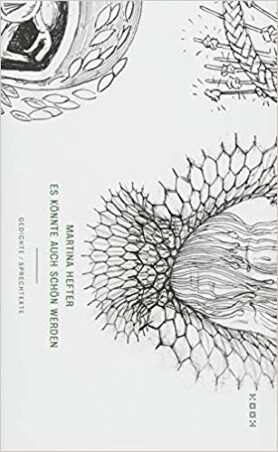Martina Hefter
Es könnte auch schön werden
[It could also be nice]
- Kookbooks Verlag
- Berlin 2018
- ISBN 978-3-937-44590-8
- 93 Pages
- Publisher’s contact details
Martina Hefter
Es könnte auch schön werden
[It could also be nice]
Published in Griechisch with a grant from Litrix.de.
Sample translations
The dance of the half-dead, very lively
In the German-speaking world, Martina Hefter (1965–) has adopted something of a pioneering role. In her new book of poems It could be nice, she describes the daily routine and atmosphere of a nursing home from her own experience with a case in her family. Or rather: she seeks and finds the poetic means of expression for the inevitable, the supposedly unspeakable, which most of us fear and therefore pretend as if it doesn’t exist. One particularity of the book emerges from the fact that some of the poems (or part of the single long poem, depending on your perspective) are meant to be texts for the stage. Martina Hefter, who left her native Allgäu region for Leipzig in the nineties and who published three novels before her four books of poetry, is not only a writer but also a dancer who works at the intersection between movement and language, performing her poetry.
The text in the book is itself dominated by relentless movement between the different pitches Hefter probes in order to create an extreme experience and not just represent one. That is, she attempts to master the existential shock through linguistic form. Balance, which is also essential for dance, has to be repeatedly reestablished between the strong emotions and the sober reflections, between empathy and self-preservation, fascination and defense. There is, on the one hand, the autobiographical situatedness in reality (the exhausting visits to the bedridden mother-in-law) as well as the cool observations regarding the routine in the nursing home where comedy is never far off. And, on the other hand, there is the devotion to one’s own imagination, which runs amok in such depressing surroundings. These two modes of perception are like two ballet bars, where the lyrical subject seeks refuge, sometimes in the slang of slam poetry and others in the pathos of melancholy. Often it is sarcastic but it is always with love.
The perspectives, however, bleed together: creatures from dreams, ghosts and devils populate reality’s macabre locales, the cat at the nursing home relates its impressions, and a mummy from a glacier speaks to the inhabitants. Gestures of devotion to others and the silent presence of endurance repeatedly provide comforting moments; a liberating anarchy unfolds in “half-dead conversations.” Full of liveliness, Martina Hefter’s poetic experiment is a kind of dance in the anteroom of the realm of the dead. And her lyrical idiom, which is very much of its time, is clear and malleable enough in its ever-shifting illuminations to allow for coherent translations into other languages.
Translated by Shane Anderson

By Kristina Maidt-Zinke
Kristina Maidt-Zinke is a book and music critic at the Süddeutsche Zeitung and also writes reviews for Die Zeit.
Publisher's Summary
How does it feel when a close relative is sick and weak and walks into my life? What happens when you are forced to die alone in a nursing home room? How and where do I want to die? Will I even make it to grow old? Will I really die? And what about the devil, is he responsible? What is the evil he supposedly embodies?
Starting from a real situation, namely having to care for a seriously ill relative in a municipal nursing home in Leipzig, "Es könnte auch schön werden" gathers a variety of texts dealing with the question of how to cope with old age and death. In their respective ways, they try to approach the omnipresent question of how to cope with old age and death not only as individuals, but also as a society.
(Text: Kookbooks Verlag)
